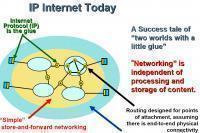About This File
Content-centric networking (also content-based networking) is a new approach to the architecture of computer networks notably pioneered by Van Jacobson.
Its founding principle is that a communication network should allow a user to focus on the data he or she needs rather than having to reference a specific physical location where that data is to be retrieved from. This stems from the fact that the vast majority of current Internet usage (about 90% [1]) consists of data being disseminated from a source to a number of users.
The current architecture of the Internet revolves around a conversation model created in the 1970s to allow geographically distributed users to use a few big immobile computers.[2] The content-centric approach seeks to make the basic architecture of the network to current usage patterns.
The new approach comes with a wide range of benefits one of which being building security (both authentication and ciphering) into the network and at the data level.
Despite all its advantages this idea doesn't seem to map very well to some of the current uses of the Web (like web applications where data is generated on the fly according to user actions) or real-time applications like VoIP and instant messenging. But one can envision an Internet where content-centric protocols take care of the diffusion-based uses of the network creating an overlay network while genuine conversation-centric protocols stay on the current infrastructure.


